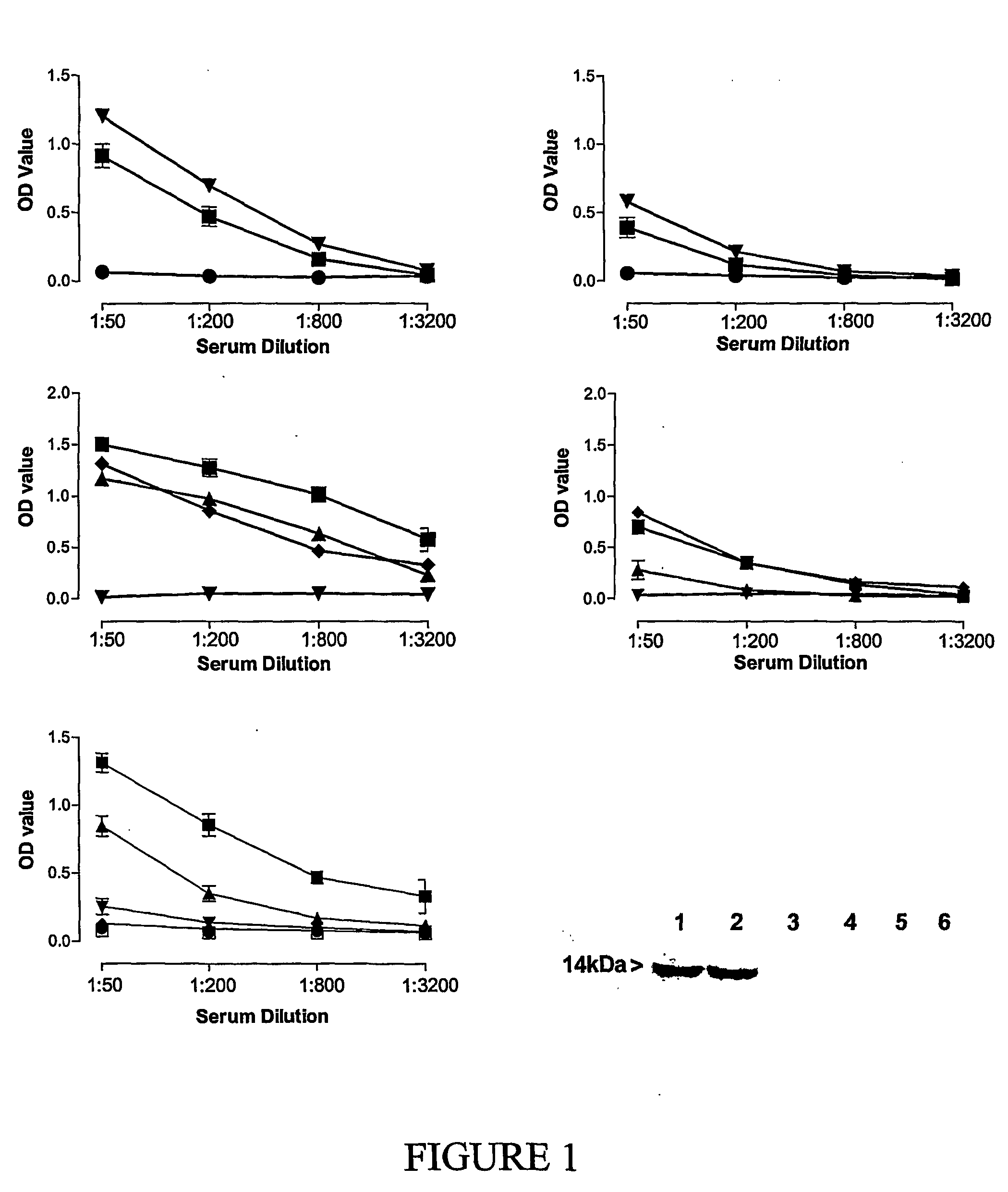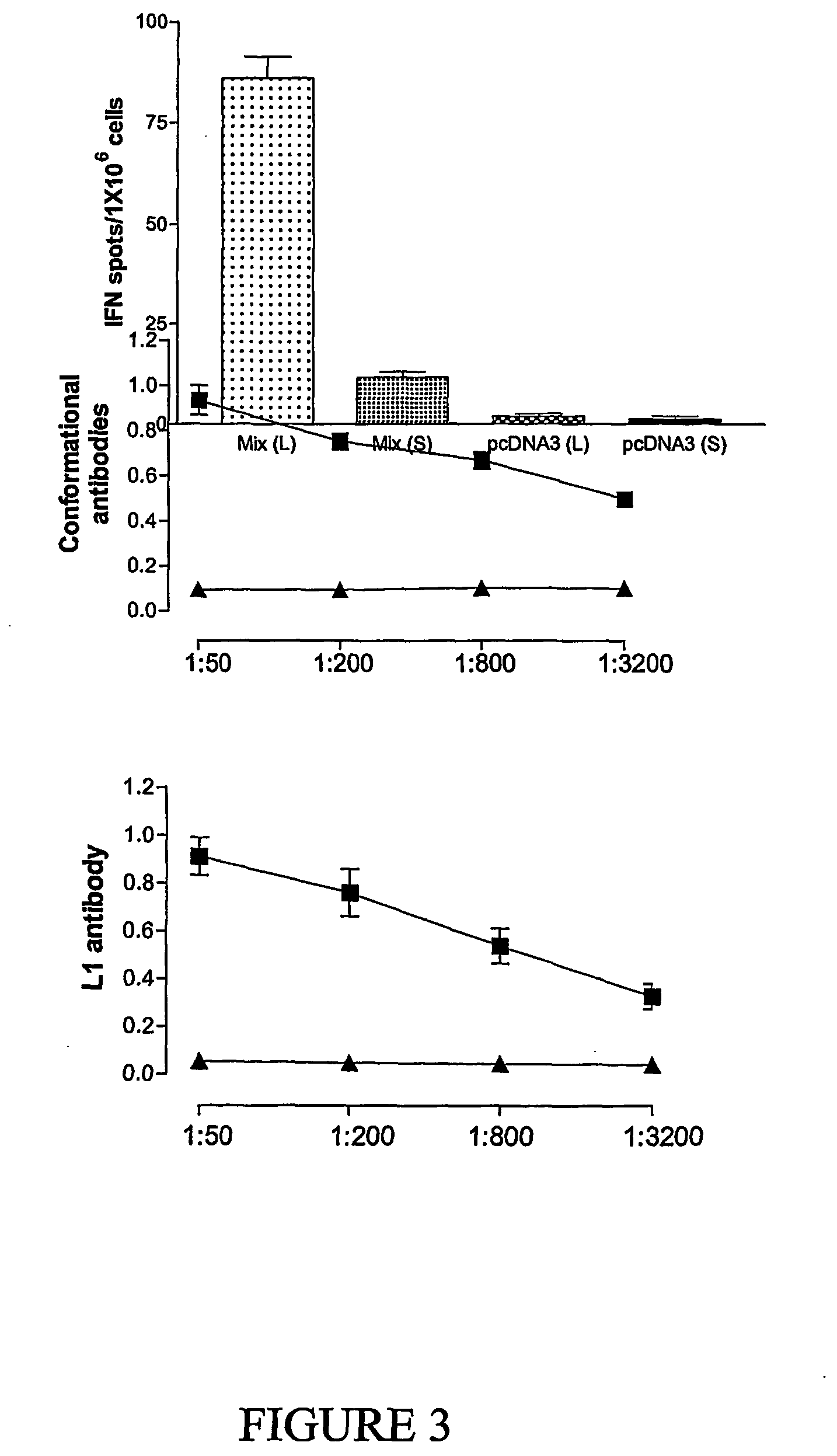Novel compositions and uses therefor
a composition and novel technology, applied in the field of compositions and methods for preventing and treating diseases or conditions, can solve the problems of inability to selectively select gene delivery systems such as vectors, and inability to produce stable integrants, etc., and achieve the effect of increasing the rate of intracellular proteolytic degradation of the second antigen
- Summary
- Abstract
- Description
- Claims
- Application Information
AI Technical Summary
Benefits of technology
Problems solved by technology
Method used
Image
Examples
example 1
[0234] Mice, DNA Immunisation and Cell Lines
[0235] Specific pathogen-free female BALB / c and C57BL / 6 mice aged 6 to 8 weeks were purchased from the Animal Resource Centre (Perth, Australia) and were maintained under clean conditions in a conventional mouse house.
[0236] Female BALB / c and C57 BL / 6 mice, 6 to 8 weeks old, were immunised by particle bombardment with DNA-coated gold beads (2 .mu.g DNA / dose) using the helium-powered Helios Gene Gun delivery system (Bio-Rad Laboratories, Richmond, Calif., U.S.A.). DNA (1.0 .mu.g) was coupled to 0.5 mg of 1.0-.mu.m-diameter gold particles, as recommended by the manufacturer. DNA-coated microcarriers were delivered into the abdominal epidermis at a helium pressure setting of 400 psi.
[0237] A human papillomavirus (HPV) 16 E7 transduced EL-4 cell line, C2.sup.36, and the parent cell line (EL-4) were maintained in complete RPMI-1640 medium plus 10% foetal bovine serum (CSL, Melbourne, Australia).
example 2
[0238] Codon Replacements in the HPV6bL1, E7 and Ubiquitin Genes
[0239] The HPV6bL1, TV6b-E7 and the human ubiquitin gene sequences were modified to substitute preferred codons for rarely used codons, according to previously described methods.sup.12. A polynucleotide encoding BPV6bL1 truncated of the C terminal 33 amino acids was made as a codon-modified construct (H6L1.DELTA.) (SEQ ID NO: 9) and also with the native codons (6L1.DELTA.) (SEQ ID NO: 7).
[0240] An HPV6bL1-E7 fusion gene (H6L1E7.1) (SEQ ID NO: 11) was constructed by adding to H6L1.DELTA. a codon-modified sequence corresponding to amino acids 2-50 of the HPV6b E7 protein. H6L1E7.2 (SEQ ID NO: 13) was similarly constructed by adding a polynucleotide encoding amino acids 49-98 of HPV6b E7, and H6L1-H16E7 (SEQ ID NO: 19) was constructed by adding a polynucleotide corresponding to the minimal H-2 D.sup.b CTL epitope of HPV16 (RAHYNIVTF). Construction of codon-modified BPV1 L2 (SEQ ID NO: 23), termed HBL2, has been described p...
example 3
[0242] Plasmid Constructions
[0243] Primers were designed to allow cloning of gene constructs into eukaryotic expression plasmids. All primers coded for one flanking EcoRI or KpnI restriction site at their N-terminus, and for 18-24 nucleotides of the corresponding gene. These were used to amplify PV gene sequences by PCR. Amplified PCR products were cut with KpnI and EcoRI restriction enzymes andn, ligated to the pCDNA3 mammalian expression vector containing the simian virus 40 (SV40) ori (hivitrogen, Carlsbad, Calif., U.S.A.) to produce the corresponding expression plasmids.
PUM
| Property | Measurement | Unit |
|---|---|---|
| Fraction | aaaaa | aaaaa |
| Fraction | aaaaa | aaaaa |
| Electric potential / voltage | aaaaa | aaaaa |
Abstract
Description
Claims
Application Information
 Login to View More
Login to View More - R&D
- Intellectual Property
- Life Sciences
- Materials
- Tech Scout
- Unparalleled Data Quality
- Higher Quality Content
- 60% Fewer Hallucinations
Browse by: Latest US Patents, China's latest patents, Technical Efficacy Thesaurus, Application Domain, Technology Topic, Popular Technical Reports.
© 2025 PatSnap. All rights reserved.Legal|Privacy policy|Modern Slavery Act Transparency Statement|Sitemap|About US| Contact US: help@patsnap.com



